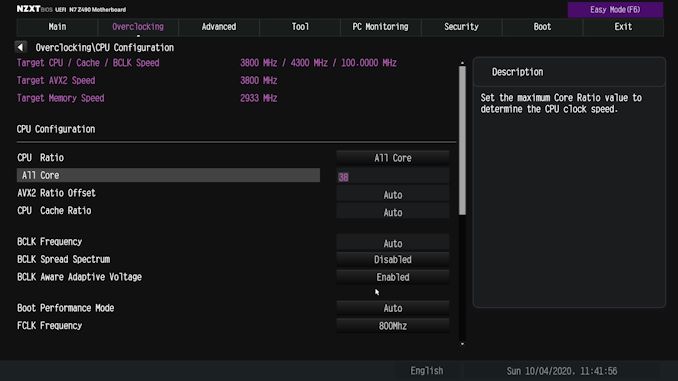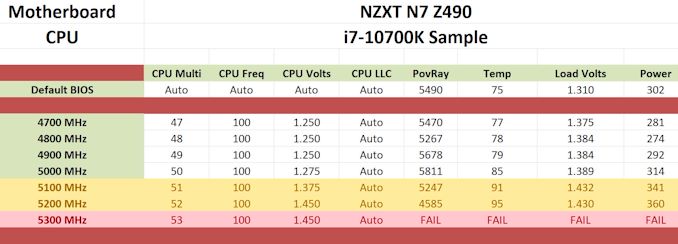The NZXT N7 Z490 Motherboard Review: From A Different Direction
by Gavin Bonshor on October 7, 2020 10:30 AM EST- Posted in
- Motherboards
- Intel
- ASRock
- NZXT
- Z490
- Comet Lake
- Intel 10th Gen
- i7-10700K
- N7 Z490
Overclocking
Experience with the NZXT N7 Z490
One of the best ways to benefit from Intel's 10th generation Comet Lake desktop processors at stock is to keep them cooled effectively and efficiently. This is due to the inner workings of how Intel's Thermal Velocity Boost work which when kept below 70°C, allows the fastest two cores to achieve faster speeds than Turbo Boost Max 3.0 does. This can be a very nice burst of 'free' performance, with Intel recommending premium cooling for the most efficient performance; this includes at least a 240 mm AIO for the Core i7-10700K, and at least a 280 mm for the top SKU, the Core i9-10900K. By default, the Comet Lake desktop processors run warm, and many vendors are using very aggressive profiles within the firmware to give them the edge over the competition, some more aggressive than others.
Focusing on the NZXT N7 Z490, the firmware is OEM ASRock, along with the rest of the PCB. NZXT in this scenario is the vendor, which in previous iterations of the N7, has gone with ECS as its OEM of choice. Using a more favored OEM such as ASRock has a variety of benefits, but from personal experience, overclocking on an NZXT motherboard is as good as it has ever been. All of the board's overclocking settings can be found in the Overclocking menu, with each of the main sections divided into three sub-menus, CPU, DRAM, and Voltages.
The NZXT GUI is nice, but it's clear to users familiar with ASRock's UEFI firmware that they share near-identical layouts, which offers easy access to all of the board's available settings. Although this can make specific settings easier to find due to all of the relevant settings in each sub-menu, I feel for novice users, having all of them in a list can be more beneficial. Switching constantly between three different sub-menus tweaking the same two components could lead to confusion, and as a matter to make a point, users struggling with remembering settings could write variables such as CPU ratio, CPU VCore voltage, and other related power settings down on a piece of paper to use as a reference point.
Overall the NZXT firmware doesn't feel like a finished product (check our overclocking results below to see why), with some very odd behavior, which is likely due to bad settings from the factory. Outside of the overclocking fiasco that's going on with this board, the firmware is relatively stable and easy to navigate, which is reminiscent of the fact NZXT has chosen ASRock for its OEM.
Overclocking Methodology
Our standard overclocking methodology is as follows. We select the automatic overclock options and test for stability with POV-Ray and Prime95 to simulate high-end workloads. These stability tests aim to catch any immediate causes for memory or CPU errors.
For manual overclocks, based on the information gathered from the previous testing, starts off at a nominal voltage and CPU multiplier, and the multiplier is increased until the stability tests are failed. The CPU voltage is increased gradually until the stability tests are passed, and the process repeated until the motherboard reduces the multiplier automatically (due to safety protocol) or the CPU temperature reaches a stupidly high level (105ºC+). Our testbed is not in a case, which should push overclocks higher with fresher (cooler) air.
Overclocking Results
When it comes to overclocking performance on the NZXT N7 Z490, the firmware is heavily overcompensating for voltage, with very lackluster VDroop control under load. It feels as if there is an underlying problem with the firmware, especially in regards to the level of power throttling, especially at an easily achievable overclock of 5.1 GHz. Normally our board can achieve 5.2 GHz all core in all of the Z490 boards we've tested, but this system has throttling above 5.0 GHz. With our 5.1 GHz overclock at 1.375 V in the firmware translating to a whopping 1.432V CPU VCore under load; this is a serious problem for users looking to manually overclock their CPU in this motherboard.
The effect of the throttling at 5.1 GHz shows in our POV-Ray benchmark performance. This is despite the CPU temperature still well within the thermal limitations, even with this setting disabled within the firmware. One possibility is that there could be a power limitation issue on this board within the firmware itself.
It is likely that NZXT will patch the firmware with a new revision, All of our testing was done on BIOS P1.10. We have reached out to NZXT about this issue, and they are aware. Should they fix the issue, the BIOS will be available to download at their website. For a board targeted at the K processors, it has to be able to at least push them to a good all-core turbo in line with the other offerings on the market.












45 Comments
View All Comments
Woomn 44 - Monday, October 19, 2020 - link
Download Smadav Antivirus for Windows PC – In this article, you can see how you can download and install the Smadav Antivirus for Windows PC, Laptop, and desktop for free.http://download4windows.onl/smadav-antivirus-for-p...
mrvco - Sunday, October 11, 2020 - link
RGB powa I expect.SlashZerov - Friday, October 9, 2020 - link
My system has2x USB keyboards one gaming and one for typing
1x USB mouse
1x USB headset Logitech g430
2x USB occulus rift sensors
1x USB data to USB for moving data on/off drives
I also have a couple phone chargers hanging off so yes 6 isn’t enough for the average person.
YB1064 - Wednesday, October 7, 2020 - link
Nobody is going to buy this board at the listed price. I'd pay $75-90 for it, tops. 4 layer PCB? Man this aint 1990.Operandi - Wednesday, October 7, 2020 - link
Wrong platform.Also, those heatsinks have very little surface area, more like heatbanks.
Also, also there is clean design and then there is boring. These are boring.
s.yu - Thursday, October 8, 2020 - link
I call this a clean design, half-assed clean is what's boring, this is actually so refined that the issue is getting other hardware to match them.Tomatotech - Friday, October 9, 2020 - link
For all its many fault, I do like the clean design. Reminds me a little of the various Mac Pro designs. Would be suitable for an exposed mobo mod project.I personally would prefer an even more clean look, for example removable coverings over the unused PCIe slots, both for aesthetics and to keep dust out. This mobo was made to be on display and not all mod projects use enclosed cases.
Polaris198321 - Wednesday, October 7, 2020 - link
Looks good. however no 6 SATA data ports for fully taking advantage of 2 laptop HDDs and desktop HDDs here. needs buttons for CMOS and bios resetting on io panel found on many Asus high end for the mobo and specially made self-recharging materials and censor on the chips for built-in ups battery backup for 30 minutes in case of blackouts to run in the energy-saving mode for basic needs like the internet and phone usage on a desktop and laptop. 4g LTE - 6g is a must as well if you decide to ditch cable internet for an alternative with both of them soon having yearly cable and internet/phone plans.wireless PSU ports on the mobo from the PSU might be tested for ditching the nightmare of cable management in such pc powers here once the light beam mirroring bounce and data/power reception effect is perfected without frying the PSU and mobo that both self-heal and self cool like the DPU and CPU and GPUs to come and ssds and HDDs doing the same thing with fans also on the side like on the haf x tower for vertical GPU mounting for the RTX 3090 and CPU fan mount that also rotate to go vertical to give a bigger CPU fan more breathing space to properly cool an RTX 3090 and intel i9 11 gen desktop CPU/AMD ryzen x3950 CPU with custom DDR 5/ssds from intel at 1 TB each for the ram slots here for hybrid custom video sound music creation editing and data science and gaming at 8k going foward as the bios uefi needs to have the ability for multiboot os for macOS windows OS Linux OS and chrome/andriod OS and iOS here for seamless easy file transfers to and from said devices and for network and usb/microsd backups of the mobo and oses from the mobo bios itself. tb 4 ports for any module CPUs from AMD or ryzen to boot up a dead pc for recovery on the i/o panel with 8k 2.1 HDMI ports and display ports are needed as well for connection to an lg/sony 8k tv theater system with sound systems that can handle live music/video/audio editing and recordings like seen and found on many movie and music recording stations.
firewrath9 - Wednesday, October 7, 2020 - link
watOperandi - Wednesday, October 7, 2020 - link
Huh...... don't do drugs I guess?